山东商业职业技术学院单独招生英语考试大纲
- 格式:doc
- 大小:22.50 KB
- 文档页数:6
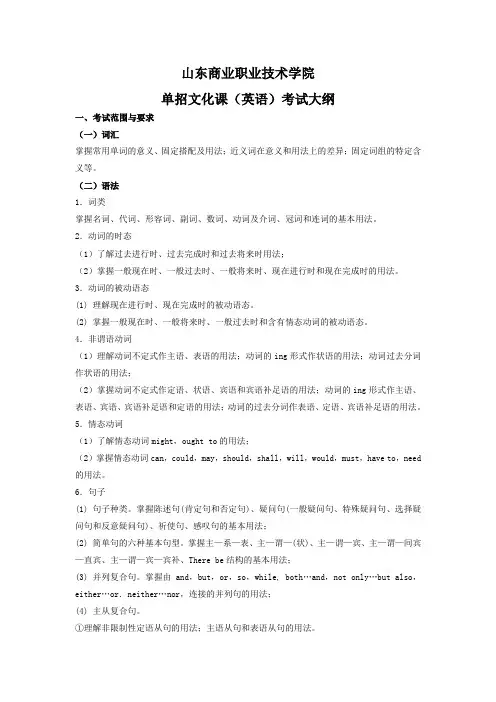
山东商业职业技术学院单招文化课(英语)考试大纲一、考试范围与要求(一)词汇掌握常用单词的意义、固定搭配及用法;近义词在意义和用法上的差异;固定词组的特定含义等。
(二)语法1.词类掌握名词、代词、形容词、副词、数词、动词及介词、冠词和连词的基本用法。
2.动词的时态(1)了解过去进行时、过去完成时和过去将来时用法;(2)掌握一般现在时、一般过去时、一般将来时、现在进行时和现在完成时的用法。
3.动词的被动语态(1) 理解现在进行时、现在完成时的被动语态。
(2) 掌握一般现在时、一般将来时、一般过去时和含有情态动词的被动语态。
4.非谓语动词(1)理解动词不定式作主语、表语的用法;动词的ing形式作状语的用法;动词过去分词作状语的用法;(2)掌握动词不定式作定语、状语、宾语和宾语补足语的用法;动词的ing形式作主语、表语、宾语、宾语补足语和定语的用法;动词的过去分词作表语、定语、宾语补足语的用法。
5.情态动词(1)了解情态动词might,ought to的用法;(2)掌握情态动词can,could,may,should,shall,will,would,must,have to,need 的用法。
6.句子(1) 句子种类。
掌握陈述句(肯定句和否定句)、疑问句(一般疑问句、特殊疑问句、选择疑问句和反意疑问句)、祈使句、感叹句的基本用法;(2) 简单句的六种基本句型。
掌握主—系—表、主—谓—(状)、主—谓—宾、主—谓—间宾—直宾、主—谓—宾—宾补、There be结构的基本用法;(3) 并列复合句。
掌握由and,but,or,so,while, both…and,not only…but also,either…or.neither…nor,连接的并列句的用法;(4) 主从复合句。
①理解非限制性定语从句的用法;主语从句和表语从句的用法。
②掌握关系副词when,where,why引导的限制性定语从句的用法。
③掌握由关系代词who,whom,whose,which,that引导的限制性定语从句的用法。

考单招——上高职单招网2016年山东商业职业技术学院单招英语模拟试题(含答案解析)第一节:单项选择(共10小题;每小题1分,满分10分)从A、B、C、D四个选项中,选出可以填入空白处的最佳选项,并在答题卡上将该项涂黑。
21.Do what he wants,or you will him.A. ignoreB. upsetC. destroyD. calm22.She made her diary the best friend and all her thoughts in it .A. set downB.set outC. set upD.set off23.If you listen to English programs every day, I am sure you will make progress in English.A. graduallyB. hardlyC.frequentlyD.fluently24.From her ,I guess she must come from the west of America.A. soundB. voiceC. noiseD. accent25.He knows _____ to deal with man but when he meets women, he doesn’t know ____ to do.A. what; howB. what; whatC. how; whatD. how; how26.When I was walking in the street, I to meet a friend of mine.A. happenB. happenedC. take placeD. took place27.The teacher told us that light faster than sound.A. travelledB. had travelledC. is travellingD. travels28.The Chinese are the 29th Olympic Games held in Beijing in 2008.A. pride inB. proud inC.proud ofD. pride of29.In that big earthquake all their houses were ,so they had to build new ones.A. destroyedB. injuredC.harmedD. hurt考单招——上高职单招网30.Please keep while I take a photograph of you.A. calmB. quietC. stillD.silent第二节:完形填空(共20小题;每小题1分,满分20分)阅读下面短文,从短文后所给各题的第四个选项(A、B、C和D)中,选出可以填入空白处的最佳选项,并在答题卡上将该项涂黑。

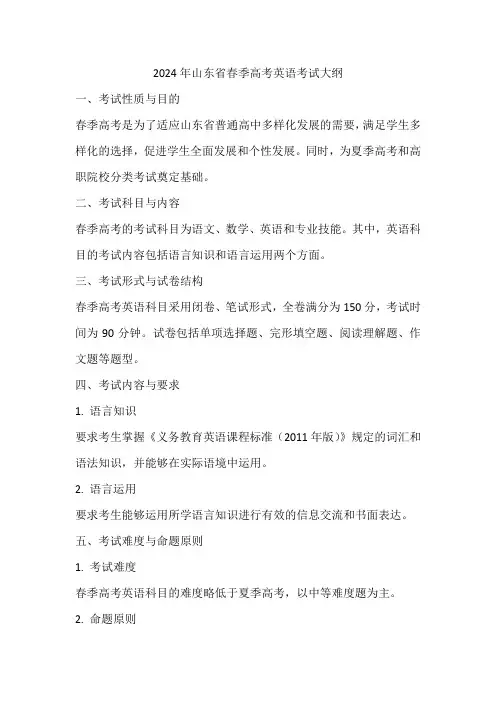
2024年山东省春季高考英语考试大纲
一、考试性质与目的
春季高考是为了适应山东省普通高中多样化发展的需要,满足学生多样化的选择,促进学生全面发展和个性发展。
同时,为夏季高考和高职院校分类考试奠定基础。
二、考试科目与内容
春季高考的考试科目为语文、数学、英语和专业技能。
其中,英语科目的考试内容包括语言知识和语言运用两个方面。
三、考试形式与试卷结构
春季高考英语科目采用闭卷、笔试形式,全卷满分为150分,考试时间为90分钟。
试卷包括单项选择题、完形填空题、阅读理解题、作文题等题型。
四、考试内容与要求
1. 语言知识
要求考生掌握《义务教育英语课程标准(2011年版)》规定的词汇和语法知识,并能够在实际语境中运用。
2. 语言运用
要求考生能够运用所学语言知识进行有效的信息交流和书面表达。
五、考试难度与命题原则
1. 考试难度
春季高考英语科目的难度略低于夏季高考,以中等难度题为主。
2. 命题原则
命题应遵循《山东省2024年春季高考英语考试说明》的要求,以考查基础知识和基本技能为主,同时注重考查学生的实际应用能力。
六、备考建议
考生在备考过程中,应注重基础知识的学习和巩固,加强阅读理解和写作训练,提高自己的实际应用能力。
同时,注意了解考试形式和要求,熟悉各种题型的特点和解题技巧。
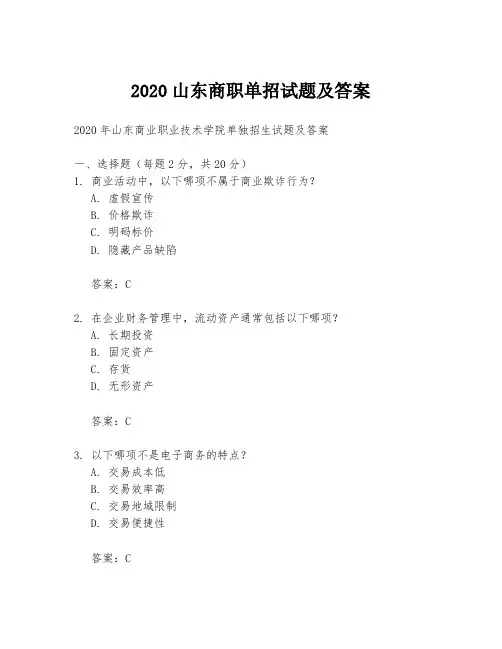
2020山东商职单招试题及答案2020年山东商业职业技术学院单独招生试题及答案一、选择题(每题2分,共20分)1. 商业活动中,以下哪项不属于商业欺诈行为?A. 虚假宣传B. 价格欺诈C. 明码标价D. 隐藏产品缺陷答案:C2. 在企业财务管理中,流动资产通常包括以下哪项?A. 长期投资B. 固定资产C. 存货D. 无形资产答案:C3. 以下哪项不是电子商务的特点?A. 交易成本低B. 交易效率高C. 交易地域限制D. 交易便捷性答案:C4. 市场营销中的4P理论指的是哪四个方面?A. 产品、价格、地点、促销B. 人员、过程、物理证据、产品C. 计划、执行、检查、行动D. 预测、定位、策略、价格答案:A5. 以下哪项不是企业社会责任(CSR)的内容?A. 提供优质的产品和服务B. 遵守法律法规C. 追求最大化利润D. 关注环境保护答案:C6. 以下哪个选项是企业进行市场细分的依据?A. 地理位置B. 产品种类C. 生产成本D. 销售渠道答案:A7. 在国际贸易中,FOB价格指的是什么?A. 离岸价格B. 到岸价格C. 成本加运费D. 出厂价格答案:A8. 以下哪项不是影响消费者购买行为的因素?A. 文化因素B. 社会因素C. 个人因素D. 产品价格答案:D9. 以下哪个选项是企业进行市场定位的策略?A. 价格领先B. 质量领先C. 服务领先D. 所有以上选项答案:D10. 在现代企业中,以下哪项不是信息技术的应用?A. 客户关系管理(CRM)B. 供应链管理(SCM)C. 企业资源规划(ERP)D. 手工会计记录答案:D二、填空题(每题2分,共20分)11. 企业在进行市场调研时,常用的数据分析方法包括________和________。
答案:定性分析、定量分析12. 企业经营战略中的SWOT分析包括分析企业的优势(Strengths)、劣势(Weaknesses)、机会(Opportunities)和________。
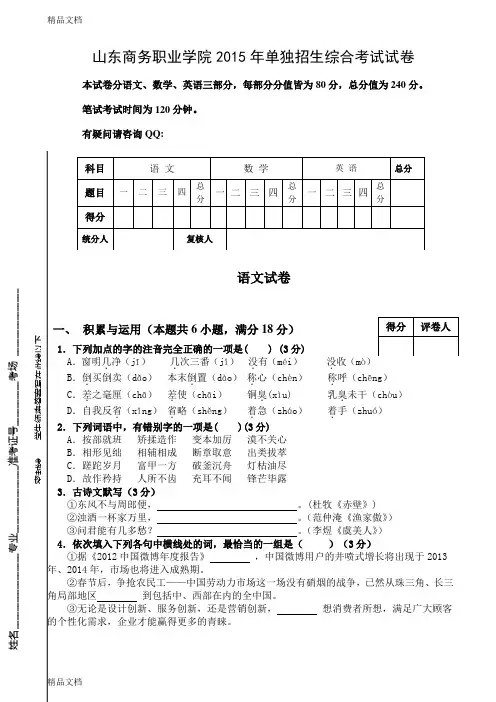
山东商务职业学院2015年单独招生综合考试试卷本试卷分语文、数学、英语三部分,每部分分值皆为80分,总分值为240分。
笔试考试时间为120分钟。
有疑问请咨询QQ:语文试卷一、 积累与运用(本题共6小题,满分18分).下列加点的字的注音完全正确的一项是( ) (3分).窗明几.净(j ī) 几.次三番(j ǐ) 没.有(m éi ) 没.收(m ò) .倒.买倒卖(d ǎo ) 本末倒.置(d ào ) 称.心(ch èn ) 称.呼(ch ēng ) C .差.之毫厘(ch ā) 差.使(ch āi ) 铜臭.(x ìu) 乳臭.未干(ch òu ) D .自我反省.(x ǐng ) 省.略(sh ěng ) 着.急(zh áo ) 着.手(zhu ó) .下列词语中,有错别字的一项是( )(3分) .按部就班 矫揉造作 变本加厉 漠不关心 .相形见绌 相辅相成 断章取意 出类拔萃 .蹉跎岁月 富甲一方 破釜沉舟 灯枯油尽 .故作矜持 人所不齿 充耳不闻 锋芒毕露 .古诗文默写(3分)①东风不与周郎便, 。
(杜牧《赤壁》) ②浊酒一杯家万里, 。
(范仲淹《渔家傲》) ③问君能有几多愁? 。
(李煜《虞美人》) .依次填入下列各句中横线处的词,最恰当的一组是( )(3分)①据《2012中国微博年度报告》 ,中国微博用户的井喷式增长将出现于20132014年,市场也将进入成熟期。
②春节后,争抢农民工——中国劳动力市场这一场没有硝烟的战争,已然从珠三角、长三角局部地区 到包括中、西部在内的全中国。
③无论是设计创新、服务创新,还是营销创新, 想消费者所想,满足广大顾客A .预测 漫延 只要B .预算 蔓延 只要C .预算 漫延 只有D .预测 蔓延 只有5.下列句子中,加点的成语使用不恰当的一项是( )(3分)A .有些中小网站为换取更多的商业利益,不惜大打擦边球,放任黄、赌、毒及虚假信息,炒作耸人听闻....的传言,以迎合一些网民的猎奇八卦心理。
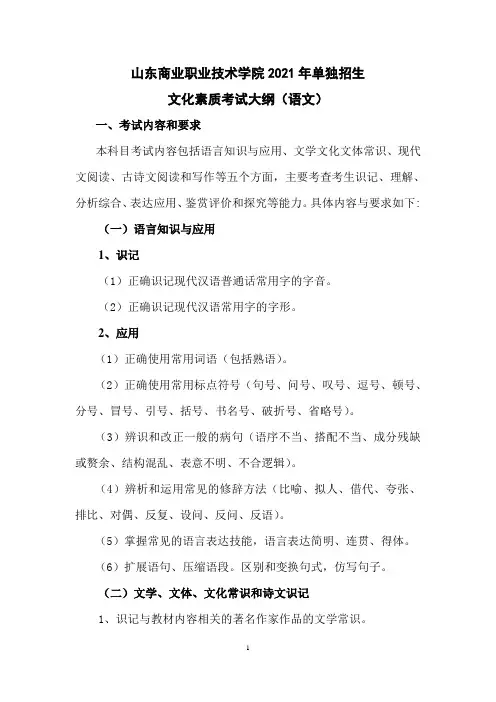
山东商业职业技术学院2021年单独招生文化素质考试大纲(语文)一、考试内容和要求本科目考试内容包括语言知识与应用、文学文化文体常识、现代文阅读、古诗文阅读和写作等五个方面,主要考查考生识记、理解、分析综合、表达应用、鉴赏评价和探究等能力。
具体内容与要求如下: (一)语言知识与应用1、识记(1)正确识记现代汉语普通话常用字的字音。
(2)正确识记现代汉语常用字的字形。
2、应用(1)正确使用常用词语(包括熟语)。
(2)正确使用常用标点符号(句号、问号、叹号、逗号、顿号、分号、冒号、引号、括号、书名号、破折号、省略号)。
(3)辨识和改正一般的病句(语序不当、搭配不当、成分残缺或赘余、结构混乱、表意不明、不合逻辑)。
(4)辨析和运用常见的修辞方法(比喻、拟人、借代、夸张、排比、对偶、反复、设问、反问、反语)。
(5)掌握常见的语言表达技能,语言表达简明、连贯、得体。
(6)扩展语句、压缩语段。
区别和变换句式,仿写句子。
(二)文学、文体、文化常识和诗文识记1、识记与教材内容相关的著名作家作品的文学常识。
2、识记与教材内容相关的文化常识。
3、识记与教材内容相关的文体常识。
4、识记常见的名句、名段和名篇。
(三)现代文阅读具备阅读理解现代社会科学类、自然科学类作品及文学作品的基本能力。
1、理解(1)理解文章所表现的人物、事件、事物、观点、情感等。
(2)理解文中重要词语和句子的含义。
2、分析综合(1)理清写作思路,把握文章结构。
(2)筛选信息,概括要点。
(3)分析总结作者在文中的观点和态度。
3、鉴赏评价(1)鉴赏文学作品中的形象、语言、表达技巧等。
(2)评价文章的思想内容和作者的观点、情感与态度等。
(四)古诗文鉴赏具备鉴赏浅易古诗文的基本能力。
1、理解(1)理解常见文言实词在文中的含义。
(2)理解常见文言虚词在文中的用法(如:何、之、而、则、以、其、于、乎、为、乃等)。
(3)理解教材内容中出现的常用通假字的含义。
(4)理解文言文中常见的词类活用现象。

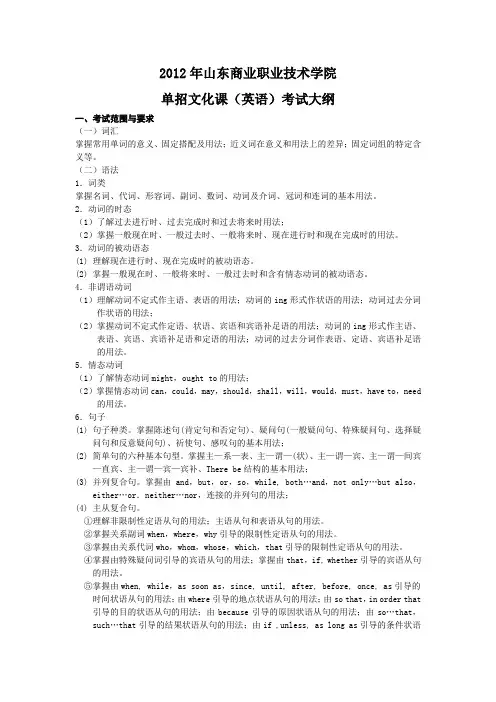
2012年山东商业职业技术学院单招文化课(英语)考试大纲一、考试范围与要求(一)词汇掌握常用单词的意义、固定搭配及用法;近义词在意义和用法上的差异;固定词组的特定含义等。
(二)语法1.词类掌握名词、代词、形容词、副词、数词、动词及介词、冠词和连词的基本用法。
2.动词的时态(1)了解过去进行时、过去完成时和过去将来时用法;(2)掌握一般现在时、一般过去时、一般将来时、现在进行时和现在完成时的用法。
3.动词的被动语态(1) 理解现在进行时、现在完成时的被动语态。
(2) 掌握一般现在时、一般将来时、一般过去时和含有情态动词的被动语态。
4.非谓语动词(1)理解动词不定式作主语、表语的用法;动词的ing形式作状语的用法;动词过去分词作状语的用法;(2)掌握动词不定式作定语、状语、宾语和宾语补足语的用法;动词的ing形式作主语、表语、宾语、宾语补足语和定语的用法;动词的过去分词作表语、定语、宾语补足语的用法。
5.情态动词(1)了解情态动词might,ought to的用法;(2)掌握情态动词can,could,may,should,shall,will,would,must,have to,need 的用法。
6.句子(1) 句子种类。
掌握陈述句(肯定句和否定句)、疑问句(一般疑问句、特殊疑问句、选择疑问句和反意疑问句)、祈使句、感叹句的基本用法;(2) 简单句的六种基本句型。
掌握主—系—表、主—谓—(状)、主—谓—宾、主—谓—间宾—直宾、主—谓—宾—宾补、There be结构的基本用法;(3) 并列复合句。
掌握由and,but,or,so,while, both…and,not only…but also,either…or.neither…nor,连接的并列句的用法;(4) 主从复合句。
①理解非限制性定语从句的用法;主语从句和表语从句的用法。
②掌握关系副词when,where,why引导的限制性定语从句的用法。
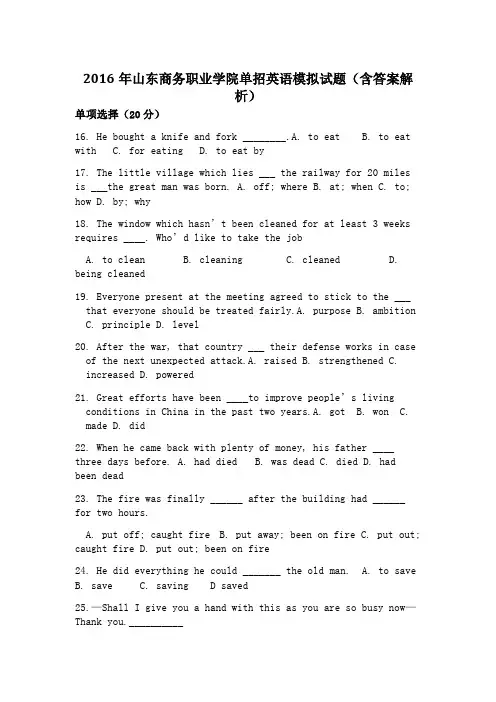
2016年山东商务职业学院单招英语模拟试题(含答案解析)单项选择(20分)16. He bought a knife and fork ________.A. to eat B. to eat with C. for eating D. to eat by17. The little village which lies ___ the railway for 20 milesis ___the great man was born. A. off; where B. at; when C. to; how D. by; why18. The window which hasn’t been cleaned for at least 3 weeks requires ____. Who’d like to take the jobA. to cleanB. cleaningC. cleanedD.being cleaned19. Everyone present at the meeting agreed to stick to the ___that everyone should be treated fairly.A. purpose B. ambition C. principle D. level20. After the war, that country ___ their defense works in caseof the next unexpected attack.A. raised B. strengthened C. increased D. powered21. Great efforts have been ____to i mprove people’s living conditions in China in the past two years.A. got B. won C. made D. did22. When he came back with plenty of money, his father ____three days before. A. had died B. was dead C. died D. hadbeen dead23. The fire was finally ______ after the building had ______for two hours.A. put off; caught fireB. put away; been on fireC. put out; caught fireD. put out; been on fire24. He did everything he could _______ the old man. A. to saveB. saveC. saving D saved25.—Shall I give you a hand with this as you are so busy now—Thank you.__________A. Of course you canB. If you likeC. it’s up to youD. It couldn’t be better26. Everyone has periods in their lives _____ everything seemsvery hard.A. when B. where C. which D. that27. When he heard the news, he hurried home,______ the book______ on the desk.A. leaving; lying openB. to leave; lying openC. left;lying open D. leaving; lying opened28. Who do you think he would _____ a letter of congratulationto our monitorA. have writtenB. have to writeC. have writeD.have been writing29. Taiyuan, _____ in the centre of Shanxi province is a mostbeautiful city. A. located B. to locate C. locate D. locating30. I was told that there were about 50 foreign students_____Chinese in the school, most____were from Germany.A. study, of whomB. study, of themC. studying, of themD. studying, of whom31. Hurricane brought down a great number of houses, _____thousands of people homeless.A. to make B. making C. made D.having made32. We need clean air, but ___, air pollution is generallypresent, especially in cities.A. fortunately B. strangely C.sadly D. hopefully33. I feel greatly honoured _____ the chance to speak here.I’m feeling very excited.A. to giveB. to be givingC. to have been givenD. to have given34.___ two children attending college, the parents have to workreally hard to make the ends meet. A. From B. For C. Of D.With35. — Sorry to have hurt you the other day. — _____, butdon’t do it again.A. Forget itB. Don’t mention itC. Don’t worryD. With pleasure完型填空(20分)Perhaps the most interesting person I have ever met is an Italian professor of philosophy who teaches at the University of Pisa. 36 I last met this man eight years ago, I have not forgotten his 37 qualities. First of all, I respected his 38 to teaching. Because his lectures were always well-prepared and clearly delivered, students crowdedinto his classroom. His followers liked the fact that he 39 what he taught Further more, he could be counted on to explain his ideas in an 40 way, introducing such aids (辅助) to41 as oil paintings, music, and guest lecturers. Once he42 sang a song in class in order to make a point clear.43 , I admired the fact that he would talk to studentsoutside the classroom or talk with them 44 the telephone. Drinking coffee in the cafe, he would easily make friends with students. Sometimes he would 45 a student to a game ofchess (国际象棋) 46 he would join student groups todiscuss a variety of 47 : agriculture, diving and mathematics. Many young people visited him in his office for 48 on their studies; others came to his home for social evenings. Finally, I was 49 by his lively sense of humor. He believed that no lesson is a success 50 , during it, the students and the professor 51 at least one loud 52 . Through his sense of humor, he made learning more 53 and more lasting, If it is 54 that life makes a wise man smile and a foolish man cry, 55 my friend is indeed a wise man.36. A. Although B. When C. Even if D. Now that 37.A. basicB. specialC. commonD. particular38. A. attention B. introduction C. relation D. Devotion39.A. insisted onB. talked aboutC. believed inD. agreed with40. A. imaginative B. ordinary C. opposite D. open41. A. listening B. understanding C. information D. discovery42. A. also B. nearly C. even D. only43. A. Later B. Secondly C. However D. Therefore44. A. with B. by C. from D. on45. A. inviteB. leadC. preferD. show46. A. As a matter of fact B. Later on C. Other times D.In general47. A. questions B. subjects C. matters D. contents48. A. support B. explanation C. experience D. advice49.A. disturbedB. movedC. attractedD. defeated50. A. for B. until C. since D. unless 51. A. hearB. suggestC. shareD. demand52. A. laugh B. cry C. shout D. question53. A. helpful B. enjoyable C. practical D. useful54. A. natural B. normalC. hopeful D. true55. A. so B. forC. thenD. yetIV.阅读理解(30分)A One evening after dinner, Mr. and Mrs. Tisich called afamily meeting. “We’ve had to make a difficult decision,” Mr. Tisich announced. “You see, your m other has been offered apost as co-director of a television station in Chicago. Unfortunately, the station is not here. After thinking long andhard about it, we’ve concluded that the right decision is tomove to Chicago.” Marc looked shocked, while his sisterRachel breathlessly started asking when they’d be moving.“It’s surprising, but exciting” she said. Marc simply said,“We can’t go—I can’t leave all my friends. I’d rather stayhere and live with Tommy Lyons” The Tisichs hoped that bythe time they moved in August, Marc would grow more accustomedto the idea of leaving. However, he showed no signs ofaccepting the news, refusing to pack his belongings.When the morning of the move arrived, Marc was nowhere tobe found. His parents called Tommy Lyons’ house, but Mrs.Lyons said she hadn’t seen Marc. Mrs. Tisich becameincreasingly concerned, while her husband felt angry with their son for behaving so irresponsibly.What they didn’t know was that Marc had started walki ngover to Tommy’s house, with a faint idea of hiding in Lyons’ attic(阁楼) for a few days. But something happened on the wayas Marc walked past all the familiar landscape of the neighborhood: the fence that he and his mother painted, thetree that he and his sister used to climb, the park where heand his father often took evening walks together. How muchwould these mean without his family, who make them special inthe first place Marc didn’t take the time to answer that question but instead hurried back to his house, wondering if there were any moving cartons(纸板箱)the right size to hold his record collection.56. The conflict in this story was caused by___________.A. Marc and Rachel’s different tempersB. a quarrel between Tommy Lyons and MarcC. Marc’s disagreement with his parents about their moveD. Mr. and Mrs. Tisich’s remark of Marc’s irresponsibility57. Marc and Rachel’s reactions to the move were similar inthe way that both were____________A. surprisedB. angry and upsetC. anxious for more detailsD. worried about packing58. The reason for Marc’s going home was that_________________.A. he did not want to be left behindB. he realized his family was essential to himC. he hoped to reach an agreement with his parentsD. he wished to be a more responsible person59. What would most likely happen nextA. Marc would bring his records over to the Lyons’s house.B. Mr. and Mrs. Tisich would call the police.C. Marc would join his family for house moving.D. Mr. and Mrs. Tisich would start searching for Marc.C Deserts are found where there is little rainfall or where rain for a whole year falls in only a few weeks' time. Ten inches of rain may be enough for many plants to survive if the rain is spread throughout the year, If it falls, within one or two months and the rest of the year is dry, those plants may die and a desert may form.Sand begins as tiny pieces of rock that get smaller and smaller as wind and weather wear them down. Sand dunes are formed as winds move the sand across the desert. Bit by bit, the dunes grow over the years, always moving with the winds andchanging the shape. Most of them are only a few feet tall, but they can grow to be several hundred feet high.There is, however, much more to a desert than sand. In the deserts of the southwestern United States, cliffs and deep valleys were formed from thick mud that once lay beneath a sea more than millions of years ago. Over the centuries, the water dried up. Wind, sand, rain, heat and cold all wore away at the remaining rocks. The faces of the desert mountains are always changing—very, very slowly—as these forces of nature continue to work on the rock.Most deserts have a surprising variety of life. There are plants, animals and insects that: have adapted to life in the desert. During the heat of the day, a visitor may see very few signs of living things, but as the air begins to cool in the evening, the desert comes to life. As the sun begins to rise again in the sky, the desert once again becomes quiet and lonely.60. Many plants may survive in deserts when___________. A. the rain is spread out in a yearB. the rain falls only in a few weeksC. there is little rain in a yearD. it is dry all the year round61. Sand dunes are formed when___________. A. sand piles up graduallyB. there is plenty of rain in a yearC. the sea has dried up over the yearsD. pieces of rock get smaller62. The underlined sentence in the third paragraph probably means that in a desert there is____________.A. too much sandB. more sand than beforeC. nothing except sandD. something else besides sand63 It can be learned from the text that in a desert____________.A. there is no rainfall throughout the yearB. life exists in rough conditionsC. all sand dunes are a few feet highD. rocks are worn away only by wind and heatD When we walk through the city, we all experience a kind of information overload but we pay attention only to those thatare important to us. We don’t stop, we keep our faces expressionless and eyes straight ahead, and in doing so, we are not just protecting ourselves but are avoiding overloadingother people as well.We make use of stereotypes (刻板(de)模式) as convenient ways to make quick judgements about situations and people around us. They may not always be accurate, and they can often be dangerously wrong, but they are used regularly.The problem with the stereotypes is that they restrict experience. By using limited clues to provide us with a rapid opinion of other people or places we may choose to limit our communication. We may decide not to go to certain places because we believe they will not offer something we enjoy.In the city, styles of dress are particularly important with regard to self-presentation. Different groups often use clearly identifiable styles of clothes so that they can beeasily recognized. It is becoming increasingly common for brand names to be placed on the outside of clothes, and this labeling makes it easy to send out information about fashion and price instantly, and lets others tell at a distance whether an individual has similar tastes and is a suitable person to associate with.In England, where social grouping or class continues to make social distinctions(区分), clothes, hairstyles, people’s pronunciation and the manner of speaking are all clues to our social group. Class distinctions tend to be relatively fixed, although in the city where greater variety is permitted, they are more likely to be secondary determining factors offriendship and association.67. People walking in cities ignore the surroundings because__________.A.they do not wish to talk to other peopleB.everyoneelse is expressionlessC.the environment is already familiar to themD.there istoo much information to take in68.According to the passage, the main disadvantage of usingstereotypes is that they __________.A.are likely to lead us into dangerous situationsB.maymake us miss some pleasant experienceC.can rarely be relied onD.make usmentally lazy69.From the passage we may conclude that _________.A.stereotypes can help to understand people fullyB.people are becoming more interested in fashionC.dressing can send messages about individualsD.stereotypes can do more harm than good to people70. It would appear that in England, a person’s class__________.A.might be less important in making friends in a cityB.is mainly determined by his pronunciationC.plays less of a role than it did in the pastD.is something that can be changed easily单选16—20 BABCB 21—25 CBDAD 26—30 AACAD 31—35 BCCDA完型36. A 37. B 38. D39. C40. A 41. B 42. C43. B44. D45. A46. C47. B48. D 49. C50. D 51. C 52. A 53. B 54. D 55. C阅读(A篇)CABC (C篇)AADB (D篇)DBCA。
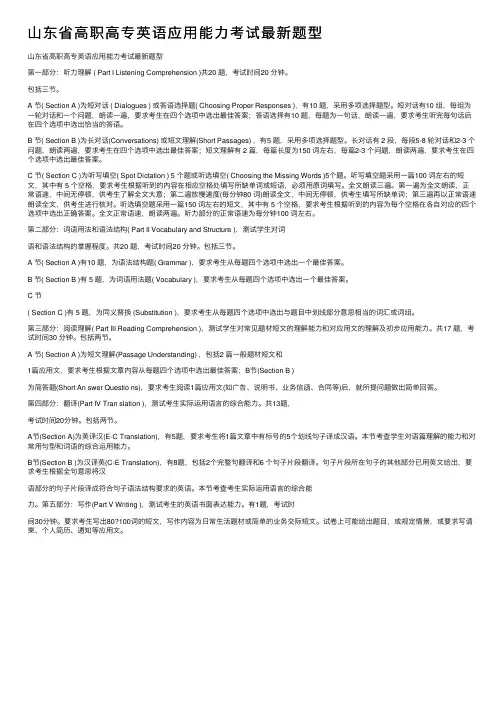
⼭东省⾼职⾼专英语应⽤能⼒考试最新题型⼭东省⾼职⾼专英语应⽤能⼒考试最新题型第⼀部分:听⼒理解 ( Part I Listening Comprehension )共20 题,考试时间20 分钟。
包括三节。
A 节( Section A )为短对话 ( Dialogues ) 或答语选择题( Choosing Proper Responses ),有10 题,采⽤多项选择题型。
短对话有10 组,每组为⼀轮对话和⼀个问题,朗读⼀遍,要求考⽣在四个选项中选出最佳答案;答语选择有10 题,每题为⼀句话,朗读⼀遍,要求考⽣听完每句话后在四个选项中选出恰当的答语。
B 节( Section B )为长对话(Conversations) 或短⽂理解(Short Passages) ,有5 题,采⽤多项选择题型。
长对话有 2 段,每段5-8 轮对话和2-3 个问题,朗读两遍,要求考⽣在四个选项中选出最佳答案;短⽂理解有 2 篇,每篇长度为150 词左右,每篇2-3 个问题,朗读两遍,要求考⽣在四个选项中选出最佳答案。
C 节( Section C )为听写填空( Spot Dictation ) 5 个题或听选填空( Choosing the Missing Words )5个题。
听写填空题采⽤⼀篇100 词左右的短⽂,其中有 5 个空格,要求考⽣根据听到的内容在相应空格处填写所缺单词或短语,必须⽤原词填写。
全⽂朗读三遍。
第⼀遍为全⽂朗读,正常语速,中间⽆停顿,供考⽣了解全⽂⼤意;第⼆遍放慢速度(每分钟80 词)朗读全⽂,中间⽆停顿,供考⽣填写所缺单词;第三遍再以正常语速朗读全⽂,供考⽣进⾏核对。
听选填空题采⽤⼀篇150 词左右的短⽂,其中有 5 个空格,要求考⽣根据听到的内容为每个空格在各⾃对应的四个选项中选出正确答案。
全⽂正常语速,朗读两遍。
听⼒部分的正常语速为每分钟100 词左右。
第⼆部分:词语⽤法和语法结构( Part II Vocabulary and Structure ),测试学⽣对词语和语法结构的掌握程度。
2024山东春季高考英语大纲全文共四篇示例,供读者参考第一篇示例:2024年山东省春季高考英语大纲一、考试内容概述2024年山东省春季高考英语考试将分为听力、阅读、写作三个部分。
考试内容涵盖了基础词汇、语法、阅读理解和写作等多个方面,旨在全面评估考生的英语综合能力。
二、考试目标1. 培养学生对英语语音、语调、语音语调的辨别能力,提高学生英语的基本运用能力;2. 考察能力考查学生运用英语进行交际的能力;3. 加强学生对英语词汇、语法和阅读能力的训练;4. 提高学生写作能力,培养学生运用英语进行表达和思维的能力。
三、考试具体要求1. 听力测试本部分分为听力理解和听力填空两大题型,主要考察考生听力理解和填空的能力。
题材广泛,包括社交场合、日常生活、学习等多个方面,题型多样,考查考生的听力反应能力和理解能力。
2. 阅读测试本部分将分为阅读理解和阅读填空两个部分,主要考察考生对英语文章的理解和阅读能力。
考题设计注重平衡,题材涵盖社会生活、文化教育、科技发展等多个领域,内容丰富多样,考查考生的阅读理解和语言表达能力。
3. 写作测试本部分将分为作文和短文填空两部分,主要考察考生的写作和表达能力。
作文要求考生根据提供的题目进行议论文或应用文的写作,要求内容实质、观点明确;短文填空要求考生根据提供的语境填入适当的单词或短语,考查考生的词汇和语法掌握情况。
四、备考建议1. 加强听力训练,梳理基础词汇和语音语调,提高对英语听力的理解和反应能力;2. 多阅读英语文章,积累词汇量和语法知识,提高阅读理解和表达能力;3. 多练习写作,培养自己的写作能力,提高语言表达和思维能力;4. 注重练习题型,熟悉考试题型和命题思路,提高应试能力。
五、总结2024年山东省春季高考英语考试要求全面评估考生的英语综合能力,考试内容涵盖听力、阅读和写作等多个方面,考查考生的听力、阅读、写作和语言表达能力。
考生在备考过程中应注重提高英语综合能力,熟悉考试要求和题型,做到知识扎实、运用灵活,全面提升自己的英语水平,取得优异成绩。
山东单招文化课考试大纲
山东单招文化课考试大纲主要包括以下内容:
1.考试范围和要求:涵盖词汇、语法、阅读理解、写作等多个方面,要求考生掌握一
定的语言知识和应用能力。
2.考试形式:通常为闭卷、笔试形式,考试时间为120分钟,试卷满分为150分。
3.考试题型:包括单项选择题、阅读理解题、完形填空题、短文改错题和书面表达题
等。
针对以上内容,考生需要注重以下几个方面的复习和准备:
1.词汇积累:掌握《中等职业学校英语教学大纲》中规定的1700个左右单词(含九年
义务教育阶段的词汇),其中要求掌握1000个左右常用词,以及200个左右的习惯用语或固定搭配及用法。
同时,要能够正确拼写所学过的单词,并了解常见词的词义和用法。
2.语法理解:理解词类(名词、代词、形容词、副词、动词、介词、冠词、连词)的
基本用法,以及动词的时态(如过去进行时、过去完成时、过去将来时等)和语态。
此外,还需要掌握简单句、并列句和复合句等句子结构。
3.阅读理解:能够读懂结构简单、题材熟悉的短文,理解文章的主旨、细节和作者的
意图。
同时,要能够运用阅读策略,如预测、略读、寻读等,提高阅读速度和效率。
4.写作训练:能够写出描述事物、表达看法的基本语句和简短文段。
在写作过程中,
要注意语句的连贯性和逻辑性,以及语法和拼写的正确性。
总之,针对山东单招文化课考试大纲的要求,考生需要全面复习和准备语言知识和应用能力,注重词汇积累、语法理解、阅读理解和写作训练等方面的提高。
同时,还要了解考试形式和题型,熟悉考试要求,以便更好地应对考试。
山东省高职高专英语应用能力考试大纲一、总则教育部颁布的《高职高专教育英语课程教学基本要求(试行)》(以下简称《基本要求》)指出:“语言测试在考核英语知识的同时,应着重考核学生实际运用语言的能力,要做到科学、公平和规范。
”同时指出:“考虑到目前学生入学英语水平的差异,教学和测试分A、B两级。
”山东省高职高专英语应用能力考试大纲就是根据这一要求而设计的。
鉴于我省实际情况,目前,山东省高职高专英语应用能力考试的内容以《基本要求》所规定的B级内容为主。
待条件成熟后,再进行A级的统一考试。
这种考试属于尺度参照性考试。
高职高专英语课程的教学目的是:“经过180~220学时的教学,使学生掌握一定的英语基础知识和技能,具有一定的听、说、读、写、译的能力,从而能借助词典阅读和翻译有关英语业务资料,在涉外交际的日常活动和业务中进行简单的口头和书面交流,并为今后进一步提高英语的交际能力打下基础。
”整个教学过程要遵循“实用为主,够用为度”的原则,“强调打好语言基础和培养语言应用能力并重;强调语言基本技能的训练和培养实际从事涉外交际活动的语言应用能力并重。
”“目前要特别注意加强听说技能的培养。
”为此,本考试主要考核学生听和读的理解能力、翻译与写作的应用能力,同时也对词语用法、语法结构的掌握程度进行考核。
本考试目前只进行笔试。
但为了贯彻《基本要求》的精神,我们把客观性试题和主观性试题的比例做了较大调整,由原来的7﹕3调整为5.5﹕4.5,考试时间为120分钟,满分100分。
二、应考对象和考试要求考试对象为高职、高专、五年一贯制高职和成人专科修完220学时英语课程的学生。
他们应掌握3400个单词和一定数量的词组的意义及基本用法,应具有基本的实际使用语法的能力,能够阅读和翻译一般题材和涉外业务交际的文字材料,能够听懂一般的对话和短文,并能写简单的关于日常生活的短文和业务应用文。
三、考试内容B级考试的内容以《基本要求》的四个附表,即交际范围表、语言技能表、语法结构表、词汇表为依据,本考试包括五个部分:听力理解、词语用法和语法结构、阅读理解、翻译和写作。
2014年国际商务专业职业技能测试内容及要求
一、测试时间
约5分钟。
二、测试形式
面试。
三、测试内容
面试考核:仪容仪表(25分)、语言表达(30分)、文化素养(25分)、专业潜质(70分)四部分。
1.仪容仪表(25 分)
仪容大方,仪表端庄,仪态自然协调,礼仪得体。
精神饱满,表情自然,面带微笑,文明有礼,举止大方。
2.语言表达( 30分)用英语做自我介绍,介绍个人爱好、兴趣,对专业的看法,时间约半分钟。
要求英语发音标准、语言流畅、突出主题、简明扼要,介绍时不得说出自己的姓名、考号、学校等个人信息。
3.文化素养(25分)
知识视野宽广,情感态度积极,道德修养高尚,对题目的回答有独到见解,论据充分,思路清晰,阐释到位。
4.专业潜质( 70 分)
综合考察学生,运用自身知识和技能,在专业认知、职业发展规划、人际沟通、社会实践、危机处理等方面,对问题进行认知、态度抉择、问题处理和危机公关的能力。
注意事项:自我介绍不允许透露个人姓名、考号、生源地等私人信息。
山东省高职高专英语应用能力考试介绍山东省高职高专英语应用能力考试是由山东省教育厅根据本省普通高校教学的实际特点和学生的实际水平独立承办的,用以衡量高职高专学生英语应用能力的考试;他不仅测试学生的英语语言水平,更注重考评学生的实际应用能力。
这一权威的合格证书是对专科毕业生英语水平的唯一认证。
整套考题考试时间为120分钟,卷面满分为100分,60分为及格,75分为良好(也是允许参加四级考试的分数段),85分为优秀,主客观题比例为5.5:4.5.此项考试对象为高职、高专、五年一贯制高职和成人专科修完220学时英语课程(即学完3个学期的实用英语课程后)的学生。
他们应掌握3400个单词和一定数量的词组的意义以及基本的实际使用语法的能力,能够阅读和翻译一般题材和涉外业务交际的文字材料,能够听懂一般的对话和短文,并能写简单的关于日常生活的短文和业务应用文。
二、题型及应考本考试共包括五个部分:(一)、听力理解:含3个环节共15题,时间为15分钟,分值为15分,每题1分。
(A节)、5组对话,每组2句话,只读1遍,对话后有1个问句,要求根据对话及问句内容从4个选项中选择正确的一项。
这个环节的对话内容为一般日常的简单交际用语,结构比较简单,如:W: Would you please give M.r Jackson a message? M: Sorry. M.r Jackson is having a holiday in Chicago.Q: What can we learn from the conversation? A) The woman is busy working B) The woman can’t take the messageC) M.r Jackson is in his office D) M.r Jackson will be back soon(注意:此节听力重点在于抓住重要词,从而寻找答案)(B节)、含2篇短文听力材料,每篇带有2-3个题(合为5题),每个题后有1个问句。
山东商业职业技术学院2018年单独招生
文化课(英语)考试大纲
一、考试范围与要求
(一)词汇
掌握常用单词的意义、固定搭配及用法;近义词在意义和用法上的差异;固定词组的特定含义等。
(二)语法
1.词类
掌握名词、代词、形容词、副词、数词、动词及介词、冠词和连词的基本用法。
2.动词的时态
(1)了解过去进行时、过去完成时和过去将来时用法;
(2)掌握一般现在时、一般过去时、一般将来时、现在进行时和现在完成时的用法。
3.动词的被动语态
(1) 理解现在进行时、现在完成时的被动语态。
(2) 掌握一般现在时、一般将来时、一般过去时和含有情态动词的被动语态。
4.非谓语动词
(1)理解动词不定式作主语、表语的用法;动词的ing形式作状语的用法;动词过去分词作状语的用法;
(2)掌握动词不定式作定语、状语、宾语和宾语补足语的用法;动词的ing形式作主语、表语、宾语、宾语补足语和定语的用法;动词
的过去分词作表语、定语、宾语补足语的用法。
5.情态动词
(1)了解情态动词might,ought to的用法;
(2)掌握情态动词can,could,may,should,shall,will,would,must,have to,need的用法。
6.句子
(1) 句子种类。
掌握陈述句(肯定句和否定句)、疑问句(一般疑问句、特殊疑问句、选择疑问句和反意疑问句)、祈使句、感叹句的基本用法;
(2) 简单句的六种基本句型。
掌握主—系—表、主—谓—(状)、主—谓—宾、主—谓—间宾—直宾、主—谓—宾—宾补、There be结构的基本用法;
(3) 并列复合句。
掌握由and,but,or,so,while, both…and,not only…but also,either…or.neither…nor,连接的并列句的用法;
(4) 主从复合句。
①理解非限制性定语从句的用法;主语从句和表语从句的用法。
②掌握关系副词when,where,why引导的限制性定语从句的用法。
③掌握由关系代词who,whom,whose,which,that引导的限制性定语从句的用法。
④掌握由特殊疑问词引导的宾语从句的用法;掌握由that,if, whether引导的宾语从句的用法。
⑤掌握由when, while,as soon as,since, until, after, before,
once, as引导的
时间状语从句的用法;由where引导的地点状语从句的用法;由so that,in order that
引导的目的状语从句的用法;由because引导的原因状语从句的用法;由so…that,such…that引导的结果状语从句的用法;由if ,unless, as long as引导的条件状语从句的用法;由as…as,than引导的比较状语从句的用法;由although(though),even though(even if )引导的让步状语从句的用法。
(5) 倒装句。
掌握由so…,neither…nor引导的倒装句的用法;
(6) 理解由it引导的强调句。
(三)日常交际用语
1.理解下列情景中的交际用语
(1) 禁止与警告(Prohibiting and warning)
(2)表扬与鼓励(Praising and encouraging)
(3)指令与要求(Giving instructions and making requests)
(4)投诉与责备(Complaining and blaming)
(5)询问与提供信息(Seeking and offering information)
2.掌握下列情景中的交际用语
(1) 问候与应答 (Greeting and responding )
(2) 引荐与介绍(Introducing oneself and others)
(3) 求职 (Looking for a job)
(4) 告别 (Saying goodbye)
(5) 感谢与应答 (Expressing thanks and responding)
(6) 劝告与建议(Giving advice and making suggestions)
(7) 就医(Seeing the doctor)
(8) 约会(Making appointments)
(9) 邀请与应答(Making invitations and responding)
(10) 偏爱、喜好与厌恶(Preferences, likes and dislikes)
(11) 道歉与应答(Making apologies and responding)
(12) 问时间、日期与应答(Asking the time, dates and responding)
(13) 问路与应答(Asking the way and responding)
(14) 购物(Shopping)
(15) 就餐(Taking meals)
(16) 打电话(Making phone calls)
(17) 谈论天气(Talking about the weather)
(18) 祝愿、祝贺与应答(Good wishes, congratulations and responses)
(19)赞同与反对(Expressing agreement and disagreement)
(20)情感表达(Expressing feelings and emotions)
(四)写作
1.掌握下列主题的写作
(1)个人与家庭(Personal information and family)
(2)学校生活 (School life)
(3)日常生活(Daily life)
(4)健康(Health)
(5)节日与习俗(Festivals and customs)
(6)休闲娱乐(Leisure and entertainment) (7)旅游与交通(Travel and transport) (8)科学技术(Science and technology) (9)居住环境(Living environment)
(10)工作(Work)
2.掌握实用应用文写作
(1)书信(Letter)
(2)通知(Notice)
(3)便条(Note)
(4)日记(Diary)
(5)电子邮件(E-mail)
二、试卷结构及说明
(一)试卷结构及题型
单项选择约20%
阅读理解约20%
根据情景补全对话约20%
阅读表达约20%
书面表达约20%
(二) 试题难易程度比例
基础知识约40%
灵活掌握约30%
综合运用约30%
(三) 几点说明
1.单项选择
主要考查常用词汇的基本用法、近义词在意义和用法上的差异、单词的固定搭配、固定词组的特定含义以及基础语法,注重词汇在一定的语境中的运用。
2.阅读理解
能够读懂句子结构比较简单的语篇:
能够根据所学构词法及上下文内容判断生词词义,以达到理解;
能够读懂与所学课文难易程度相当的不同题材和体裁的文字材料,速度为每分钟50~60个词;
3.根据情景补全对话
依据日常交际用语中要求掌握的话题,考查学生在语境中运用语言的能力。
4.阅读表达
能够理解文章的主旨大意,总结并表达出相关信息;
能够根据上下文正确理解文中句子的含义;
能够根据上下文内容和所给提示完成阅读材料所提出的要求。
5.书面表达
能够根据提示语言、图画或表格等准确理解题意,完成相应的任务。
三、考试形式
1、答卷方式:闭卷:笔试。
2、分值:总分50分。